The sugar companies have been involved in some pretty sketchy practices to get us to eat more sweets. Find out how and get my 7 steps to tame the sugar addiction.
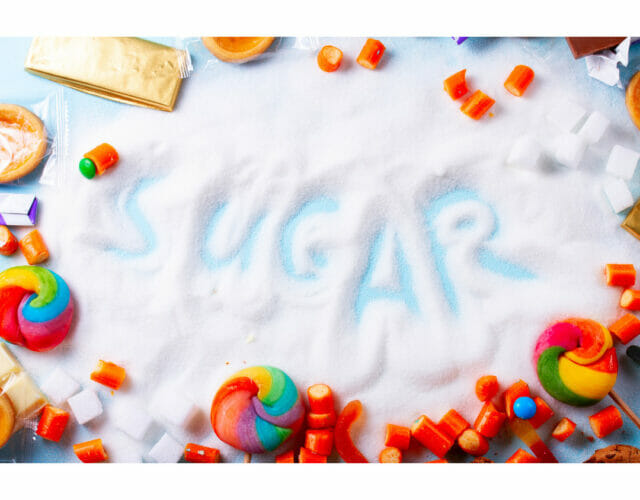
As another Easter Sunday arrives, millions of children will receive baskets full of candy or hunt for small plastic eggs containing some sweet treat. Chalk it up to another victory for the food industry marketers who have made hijacking holidays a way of American life. Confectionary sales reached a new high for 2021, pulling in nearly 29 billion dollars from Americans addicted to the sweet treats. I have to admit that historically my family was part of the holiday sugar craze. My personal favorites were the cream filled Cadbury eggs that only seem to fill the supermarket shelves once per year leading up to Easter.
How did we get here?
If you follow my blog or social media, you know that sugar has been enemy number one in my mission to improve children’s health. I have spoken at length of the negative health benefits of sugar and the long term consequences of a high sugar diet. (I also wrote a previous blog on Sugar and Eczema).
In his pivotal book Sugarproof, Michael Goran details why kids love sugar so much. “Their inborn love of sweet tastes makes evolutionary sense. It ensures that infants will like breast milk, which is sweet. As they start to wean, their preference for sweets helps them avoid bitter-tasting foods that could harm them.”
But this inbred affinity for sugar has consequences in a society that packs added sugar into so many foods. Goran also notes, “a staggering 70 percent of all packaged foods at the grocery store contain some kind of added sugar—for snack foods the number rises to 80 percent.” And the tricky part is many of the foods with lots of added sugar aren’t necessarily “sweet” foods. Rather, food companies add sugar or sweeteners to mask the taste of other chemicals and preservatives. Canned soups, bread, and salad dressings are great examples.
My husband John ran into this problem when he was trying to change his diet and improve health. He started eating protein bars for his snack rather than junk food thinking that the protein content would better satiate his appetite. This was long before the FDA required the “added sugar” line on the nutrition label, and John was much more focused on the protein content of the bar rather than the sugar. Turns out he was eating “healthy” protein bars with nearly ten grams of added sugar—more than many soft drinks! Beware of protein bars as shown below.

I discovered a number of games the food industry has been playing with us over the years. Remember the 1980’s and 90’s when we were told that fats were the real problem, and as long as we ate a low fat diet our health would benefit? It turns out when you remove all the fat from foods, they don’t taste very good. So how do you make that low fat food palatable? Pack it with sugar and get the medical community to support the change with convincing studies.
The Sugar Conspiracy
Nearly 50 years ago the sugar industry secretly paid Harvard scientists to point the blame for heart disease at fat rather than sugar. The industry had set up a research arm called the Sugar Research Foundation (SRF) whose sole purpose was to refute any bad medical publicity about the health effects of sugar. One of the researchers was both on the board of SRF and the chairman of Harvard’s Public Health Nutrition Department—massive conflict of interest.
He was paid thousands of dollars to “study” whether sugar played a role in heart disease as a number of non-sugar industry sponsored studies were showing a potential link. In 1967 the SRF sponsored review study showing fat to be a problem rather than sugar was published in the prestigious New England Journal of Medicine. And the next 50 years were set in motion with sugar replacing fat in many foods in the world—along with unprecedented levels of obesity, diabetes, eczema, asthma, allergies, ADHD, and heart disease.
Genius move from the sugar industry—but how many people have died as a result of this fraud? Why don’t we crucify Harvard and the New England Journal like we do other villains who knowingly dupe the public into some unhealthy behavior? Interestingly we eviscerated the tobacco industry for covering up research on the harmful effects of smoking, but have given sugar a pass. How many people must die from complications of sugar before we change our tune?
In 2016, researchers uncovered this conspiracy and published their results in JAMA Internal Medicine. Despite the disturbing results, it seems the Americans remain aloof to the way they are manipulated by the food industry.
Here is a disturbing fact: Over 90% of “scientific” studies sponsored by the food industry show results that favor the food industry’s interest!
Another example – On August 9, 2015 an article published in the New York Times, revealed that Coca-Cola has been funding many members of the health and scientific community with millions of dollars to promote the argument that Americans are overly fixated on how much they eat and drink and not paying enough attention to exercise. They created a Nonprofit Organization, Global Energy Balance Network, and their message is that there is simply too much blame on fast food and sugary drinks. The aim is to decrease the focus on the link between sugary beverages and obesity, despite all the medical evidence. Furthermore, they hope to convince the public that physical activity can offset a bad diet, even though there is no medical data to support this claim.
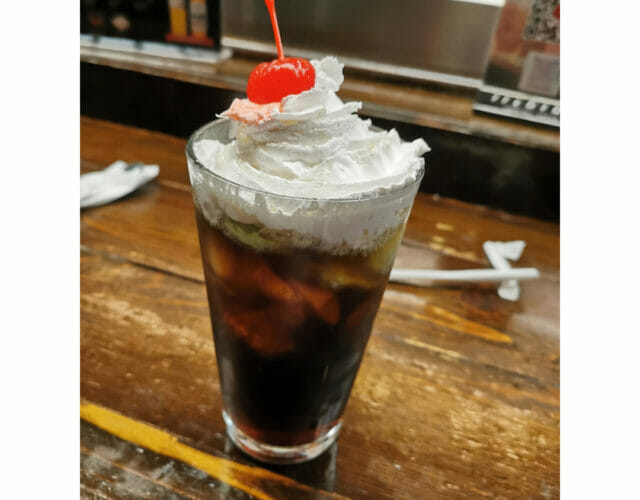
Sugar’s Dark History
It’s sadly ironic that the very thing that is currently killing millions of Americans, has historically killed many more people in the world but in different ways. A large portion of the British and American empires were built upon the spoils of the sugar trade. And the success of the sugar trade was a direct result of the African slave trade required to perform the backbreaking work of sugar cultivation. Even in modern day sugarcane production, the risks are high as sugarcane workers continue to have drastically shorter lifespans and high morbidity. Sugar workers in central america have exceedingly high rates of kidney failure, likely from overworking in the extreme heat and amongst numerous pesticides.
Not only has sugar exacted an alarming human toll, but it also has ravaged the land. The world wide fund for nature (WWF) has published a report on Sugar and the Environment. From their report:
“The cultivation and processing of sugar produce environmental impacts through the loss of natural habitats, intensive use of water, heavy use of agro-chemicals, discharge and runoff of polluted effluent and air pollution.” Basically, sugar cultivation is really hard on the environment.
Sugar Nation
During the early years of American life, the average amount of sugar consumed in the 1700s was just 4lbs per year, which is about 1 teaspoon per day. By 2000, American sugar consumption topped out at nearly 150 pounds of sugar per person each year, which is about 45 teaspoons per day!
The current recommendation from the American Heart Association is less than SIX TEASPOONS per day for children over two, and no added sugar for children under two years old.
To give you perspective, a 12-ounce can of Coca-Cola contains about nine teaspoons of sugar and a 12-ounce Mountain Dew contains eleven teaspoons. Can you imagine putting eleven teaspoons of sugar into your morning coffee? That bowl of Kellogg’s Honey Smacks gives you a nice smack in the face with four teaspoons per cup (and most cereal bowls hold more than a cup).
To help battle the problem, in 2020, the FDA began implementing new food and beverage labels (see below) to state how much added sugar each food product contains.
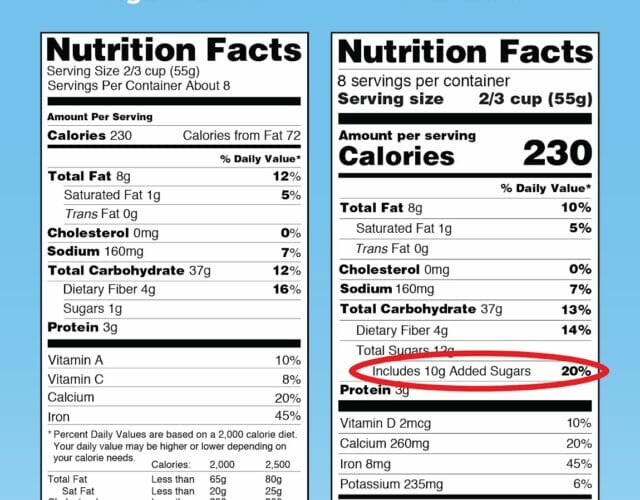
But don’t forget, sugar lurks everywhere in our food and has many different names. Here is a list of 56 alternate names for sugar found in “healthy” and “organic” foods that can fool you. Of note, there currently are more than 260 alternative names for sugar.

Alternatives to Sugar Explained
In an attempt to reduce our sugar consumption, a number of sugar alternatives have emerged, although many are problematic for other reasons. In general, sugar directly from whole fruits also contains fiber, vitamins, minerals, and antioxidants and is really the best form of sugar intake. My recommendation is that the only sugar in a child’s diet should come from whole fruits. Given about 6 to 10 percent of all US households live in a food desert (areas with limited or no access to healthy foods) this can be challenging for many families. Thus I think it’s important to have a basic understanding of sugar and its alternatives.
Let’s first address the 500 pound gorilla in the United States—high fructose corn syrup (HFCS). The government was implicit in getting us addicted to this gem, as it gave huge subsidies to farmers to grow corn and added taxes to imported pure sugarcane. HFCS quickly became the cheap alternative for food companies to sweeten their products. Coke and Pepsi both changed from sugar to HFCS in the 1980’s for the drastic cost savings. Fun fact: Europe does not allow colas with HFCS due to its detrimental health effects.
Our bodies deal with sugar (sucrose) and fructose in very different ways. The liver is the only organ that can break down fructose, and when it encounters HFCS, it gets overwhelmed. It begins to rapidly turn the fructose into fat leading to fatty liver disease and all the downstream health effects (including skin). I consider natural sugars with high levels of fructose in the same way as HFCS. These include fruit juice, fruit juice concentrates, fruit sugars (concentrates evaporated to crystalline form), and agave syrup. For example, many children’s gummy supplements are ‘made with real fruit’ however the fruit sugars may still be detrimental.
Even though whole fruit contains fructose, it does not put the same pressure on the liver. Fruits are loaded with fiber and water and have significant chewing resistance. For this reason, most fruits (like apples) take a while to eat and digest, meaning that the fructose hits the liver slowly. Plus, fruit is incredibly filling, and contains vitamins and minerals meaning eating an apple with 13 grams of fructose is more filling and nutritious than a Coke, which contains 30 grams of fructose. Much of our obesity problem is related to the fact that the Coke drinker is still hungry after finishing.
FUN FACT: it takes 4 apples to make 8oz of organic apple juice, which equals 52 grams of fructose. Apple juice has no fiber and no chewing resistance.
The chart below gives the percentage of fructose in some common sugar sources.
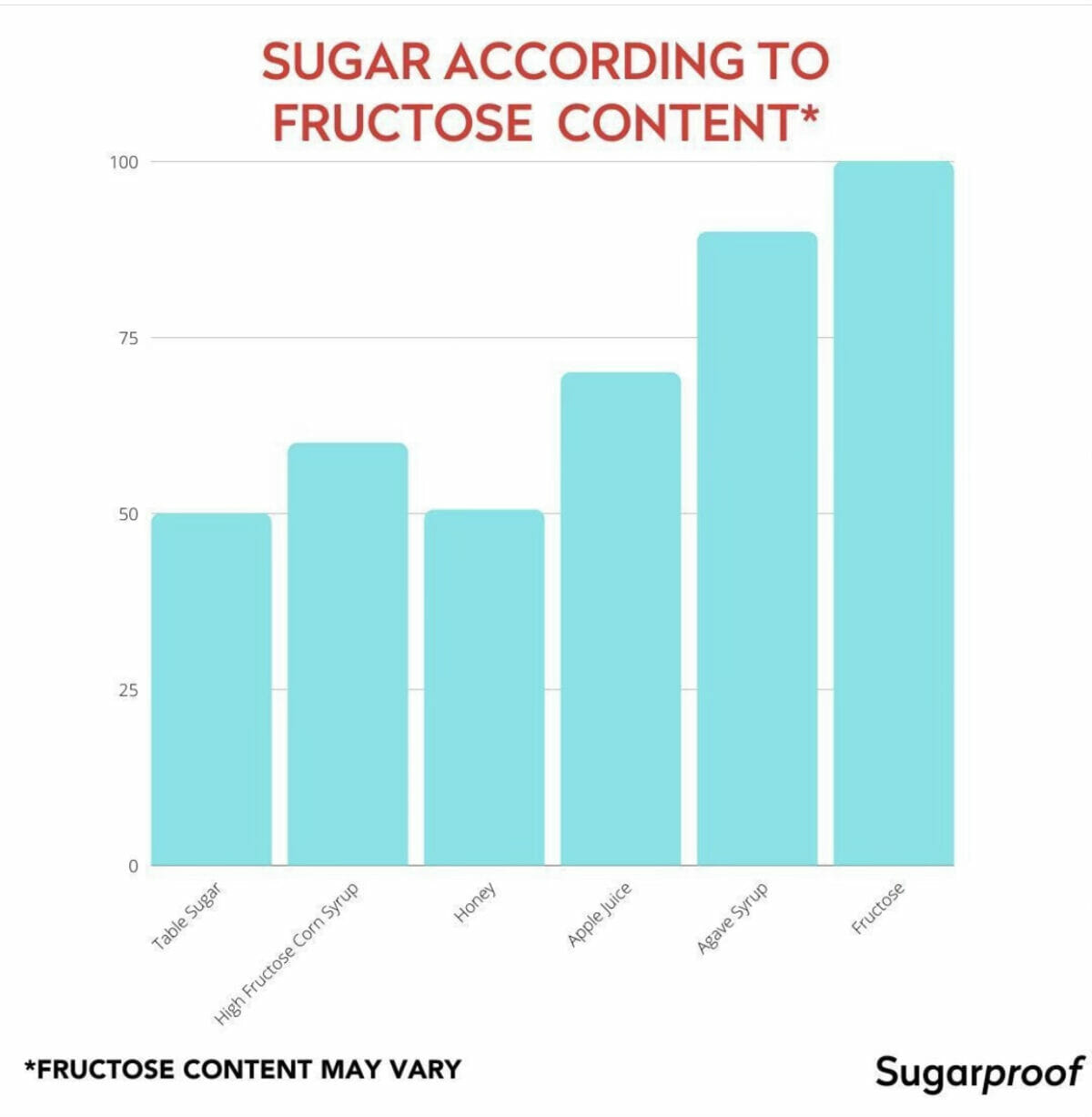
As more data emerges about the negative health effects of excess sucrose and fructose, the food company chemists have been hard at work formulating alternative sweeteners to please our palates. Many of them have been around for ages, but are getting resurrected and refined as potential healthier options but proceed with caution as these are still considered added sugar! Let’s take a look at some common sweeteners.
Natural Sugars with Lower Fructose
Dates, Date Sugar, Date Syrup: These come from date palm trees and contain fiber, potassium, copper, iron, manganese, magnesium, and vitamin B6. By retaining some of the benefits of the whole fruit, particularly fiber, date products may slow the rise in blood sugar after ingestion.
Raw, Dark, Local Honey: Made from plant nectar by bees, honey may have been the first sweetener used by humans. It is full of enzymes, antioxidants, iron, zinc, potassium, calcium, phosphorus, vitamin B6, riboflavin and niacin. Typically, the darker the honey, the more nutrient dense it is. Local honey provides you with oral tolerance to local pollen meaning it can help reduce reactions to pollen aiding seasonal allergies. Of note, pasteurized honey loses some of its health benefits.
Maple Syrup: Made from the sap of maple trees, organic, pure maple syrup is full of antioxidants, manganese, riboflavin, zinc, magnesium, calcium, and potassium. Similar to honey, darker varieties contain more antioxidants than lighter syrups.
Coconut Sugar: Extracted from the sap of the coconut flower, it is rich in polyphenols, iron, zinc, calcium, potassium, antioxidants, phosphorus and other phytonutrients. It also contains a small amount of fiber called inulin.
Organic Blackstrap Molasses: Blackstrap molasses is a byproduct of sugar cane’s refining process. Sugar cane is mashed to create juice. It’s then boiled once to create cane syrup. A second boiling creates molasses. After this syrup has been boiled a third time, a dark viscous liquid emerges known to Americans as blackstrap molasses. It has the lowest sugar content of any sugar cane product. The unique aspect of blackstrap molasses is that it’s unlike refined sugar, which has zero nutritional value. Blackstrap molasses contains vital vitamins and minerals, such as iron, calcium, magnesium, vitamin B6, and selenium.
Low Calorie Sweeteners
Low calorie sweeteners can generally be divided into two categories: artificial and natural. The taste of sweeteners are typically hundreds or even tens of thousands of times sweeter than sugar, and many times they are combined with other products to cover up bitter aftertastes. And all this without any calories? If it seems too good to be true it probably is. Although most of these products don’t actually contain calories, many of them still stimulate receptors in our bodies with downstream consequences such as insulin resistance.
Even when used in small doses, the effect on taste buds is powerful. The more sweeteners in the diet, the more we train our kid’s taste buds to crave sugar, which leads to more sugary snacks, more white carbs, and more processed foods. The whining continues, and the addiction worsens. Also, many of us see low calorie sweeteners (like Stevia and monk fruit) as “safe” or “not as bad as” sugar, giving us a false sense of security, and allowing it to infiltrate our foods, lives, and bodies.
Additionally few of them have long term studies, particularly in children, to prove their safe use in our food. Some common low calorie sweeteners are listed below.
| Artificial Low Calorie Sweeteners | Natural Low Calorie Sweeteners |
| Aspartame (Equal) | Stevia (Truvia, Pure Via, Stevia in the Raw) |
| Advantame | Monk Fruit (Pure Lo) |
| Neotame (Nutrasweet) | Yacon Syrup |
| Saccharin (Sweet’N Low | Allulose |
| Sucralose (Splenda) | Tagatose |
| AceK (Sunett or Sweet One) | |
| Cyclamate (Sugar Twin) |
Stevia andMonk Fruit
Two low calorie “natural” sweeteners that have become quite popular over the last few years are stevia leaf and monk fruit. The stevia leaf plant is native to South America and is 200 times sweeter than sugar. It has become a popular marketing slogan for “healthier products” but there are many garbage versions of this product out there. Some stevia products have a bitter aftertaste and thus a number of stevia containing products have other sweeteners added to counteract this such as erythritol. Fortunately, stevia does not directly cause weight gain or spikes in insulin. Although it is absorbed, it is quickly eliminated by the liver and kidneys and thus far has not been shown to be carcinogenic.
Unfortunately it’s not all rainbows and unicorns with stevia. If you remember back to Chapter 4 on gut health, our intestinal microbiome is vitally important to our skin and inflammatory level. Stevia has been shown in several studies to have negative effects on our gut bacteria including limiting their ability to grow by damaging their environment. Stevia makes our colon less acidic and reduces ammonium levels. In this altered environment, bacteria have difficulty producing short chain fatty acids which the colon cells use for energy.
The chart below is what I use to determine daily allowable stevia for kids.
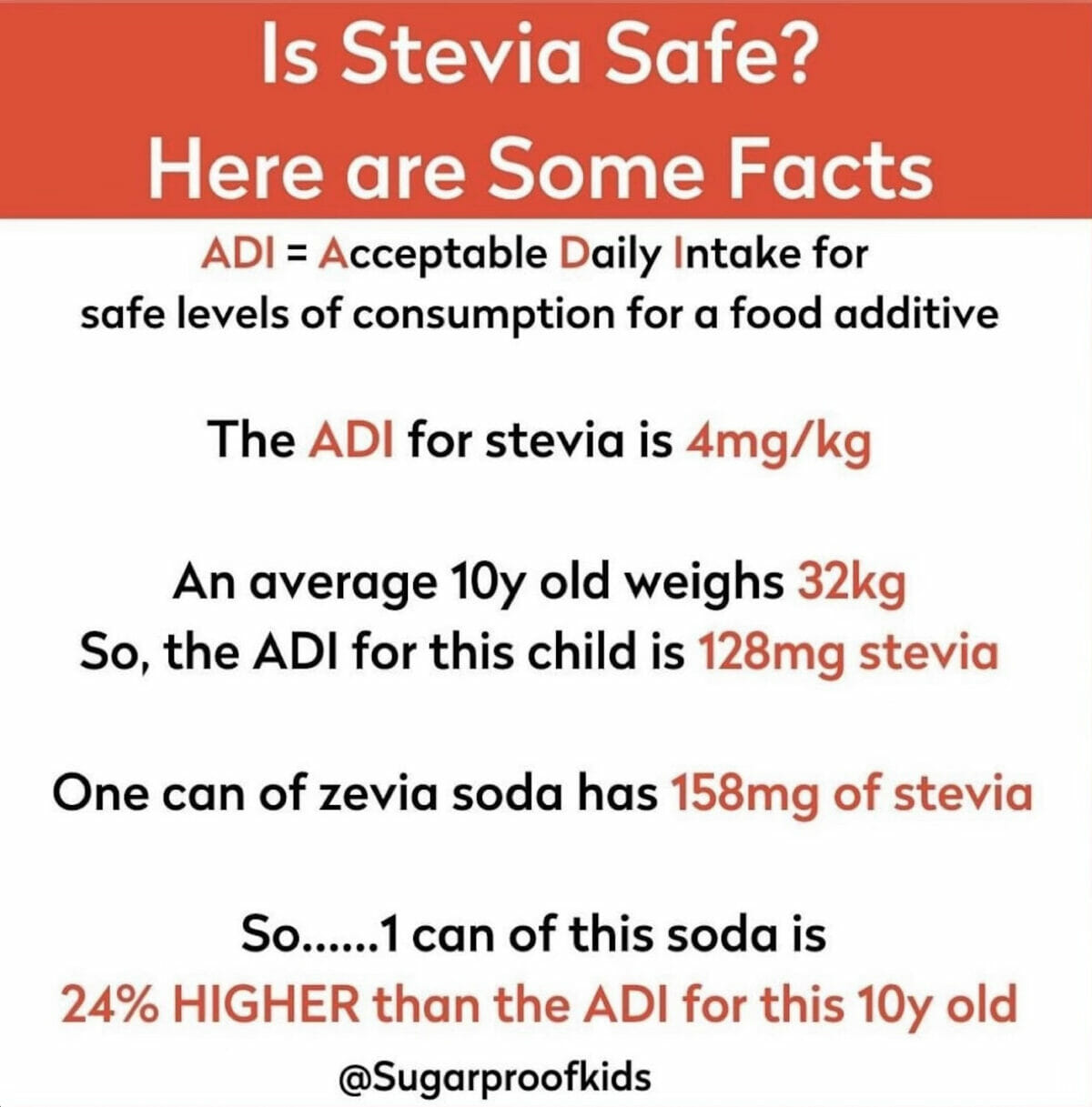
Monk fruit is a small green melon native to southeast Asia, so named from its use by monks in the 1300’s. Similar to stevia, it is often combined with sugar alcohols like xylitol or erythritol defeating the purpose of the “natural” product. These additional ingredients can cause stomach upset, vomiting and diarrhea. Similar to stevia, monk fruit also maintains a low glycemic index (no insulin spike) and does not directly lead to weight gain. No studies currently exist on the interaction of monk fruit sweeteners and our gut bacteria.
The Bottom Line
I recommend avoiding low calorie sweeteners if possible. If you must use one of these products, the natural sweeteners like stevia or monk fruit are probably the better option at this point, though studies are limited. If using these products, make sure there are no additives or preservatives, avoid liquid versions containing alcohol and make sure you count them as added sugar for the day. I use organic dates, sugar, honey, and maple syrup with a goal to keep it under 24 grams of added sugar per day.
7 Steps to Tame Sugar Holidays
Now that I have inundated you with mountains of evidence on the problems with sugar, you may be asking what to do. Here are some simple steps to take this holiday.
- Don’t make holidays about sweet treats. Find other ways to celebrate the holidays with new traditions like fun games, time outside, or scavenger hunts.
- When buying sugar make sure the brand uses Better Management Practices (BMPs) and I always buy organic to avoid pesticides and GMOs.
- Always read the “added sugar” portion of the label. Opt for brands that don’t dump buttloads of sugar in the product.
- Watch for hidden sugars like syrups and malts. Sugar goes by many names these days.
- Beware of low calorie sugar substitutes like sucralose and allulose. Even the “healthier” versions like stevia and monk fruit increase our appetite for sweet treats and often contain dangerous additives.
- Generelly, products that have “Kids” on the label are loaded with sugar. Always read the label
- Products advertising “low sugar” or “zero sugar” generally have fake sugars or non-nutritive sugar substitutes like erythritol, stevia, monk, and xylitol. Always read the list of ingredients.




